Training of Health Professionals to Promote Active Fatherhood during the Pre and Post-Natal Care to Prevent Violence against Women
Abstract
1. Introduction
2. Materials and Methods
3. Results
4. Discussion
5. Conclusions
Author Contributions
Funding
Institutional Review Board Statement
Informed Consent Statement
Data Availability Statement
Acknowledgments
Conflicts of Interest
References
- European Council. Convenzione del Consiglio d’Europa sulla Prevenzione e la Lotta Contro la Violenza nei Confronti delle Donne e la Violenza Domestica. Istanbul, Turkey, 2011; p. art.3. Available online: https://www.coe.int/en/web/conventions/full-list?module=treaty-detail&treatynum=210 (accessed on 24 April 2022).
- Intimate Partner Violence. Centers for Disease Control and Prevention (CDC). Available online: https://www.cdc.gov/violenceprevention/intimatepartnerviolence/index.html (accessed on 31 May 2022).
- World Health Organization. Global and Regional Estimates of Violence against Women: Prevalence and Health Effects of Intimate Partner Violence and Non-Partner Sexual Violence; World Health Organization: Geneva, Switzerland, 2013; Available online: https://apps.who.int/iris/handle/10665/85239 (accessed on 30 April 2022).
- World Health Organization. WHO: Addressing Violence against Women: Key Achievements and Priorities; World Health Organization: Geneva, Switzerland, 2018; Available online: https://apps.who.int/iris/handle/10665/275982 (accessed on 30 May 2022).
- United Nations. Transforming Our World: The 2030 Agenda for Sustainable Development. Available online: https://sdgs.un.org/2030agenda (accessed on 31 May 2022).
- The Office of the High Commissioner for Human Rights. United Nations. Committee on the Elimination of Discrimination against Women. General Recommendations Adopted by the Committee on the Elimination of Discrimination against Women. 2014. Available online: https://www.ohchr.org/en/treaty-bodies/cedaw/general-recommendations (accessed on 30 May 2022).
- ISTAT—Istituto Nazionale di Statistica. La Violenza Contro le Donne Dentro e Fuori la Famiglia. 2015, pp. 1–17. Available online: http://www.istat.it/it/files/2015/06/Violenze_contro_le_donne.pdf?title=Violenza+contro+le+donne+-+05%2Fgiu%2F2015+-+Testo+integrale.pdf (accessed on 27 April 2022).
- Bailey, B. Partner violence during pregnancy: Prevalence, effects, screening, and management. Int. J. Womens Health 2010, 2, 183–197. [Google Scholar] [CrossRef] [PubMed]
- Kingston, D.; Heaman, M.; Urquia, M.; O’Campo, P.; Janssen, P.; Thiessen, K.; Smylie, J. Correlates of Abuse around the Time of Pregnancy: Results from a National Survey of Canadian Women. Matern Child Health J. 2016, 20, 778–789. [Google Scholar] [CrossRef] [PubMed]
- Alhusen, J.L.; Ray, E.; Sharps, P.; Bullock, L. Intimate partner violence during pregnancy: Maternal and neonatal outcomes. J. Womens Health 2015, 24, 100–106. [Google Scholar] [CrossRef] [PubMed]
- Berhanie, E.; Gebregziabher, D.; Berihu, H.; Gerezgiher, A.; Kidane, G. Intimate partner violence during pregnancy and adverse birth outcomes: A case-control study. Reprod. Health 2019, 16, 22. [Google Scholar] [CrossRef]
- Alhusen, J.L.; Bullock, L.; Sharps, P.; Schminkey, D.; Comstock, E.; Campbell, J. Intimate partner violence during pregnancy and adverse neonatal outcomes in low-income women. J. Womens Health 2014, 23, 920–926. [Google Scholar] [CrossRef]
- García-Moreno, C.; Hegarty, K.; d’Oliveira, A.F.; Koziol-McLain, J.; Colombini, M.; Feder, G. The health-systems response to violence against women. Lancet 2015, 385, 1567–1579. [Google Scholar] [CrossRef]
- Feder, G.; Ramsay, J.; Dunne, D.; Rose, M.; Arsene, C.; Norman, R.; Kuntze, S.; Spencer, A.; Bacchus, L.; Hague, G.; et al. How far does screening women for domestic (partner) violence in different health-care settings meet criteria for a screening programme? Systematic reviews of nine UK National Screening Committee criteria. Health Technol. Assess 2009, 13, iii-347. [Google Scholar] [CrossRef]
- Roelens, K.; Verstraelen, H.; Van Egmond, K.; Temmerman, M. A knowledge, attitudes, and practice survey among obstetrician-gynaecologists on intimate partner violence in Flanders, Belgium. BMC Public Health 2006, 6, 238. [Google Scholar] [CrossRef]
- World Health Organization. Caring for Women Subjected to Violence: A WHO Curriculum for Training Health-Care Providers; World Health Organization: Geneva, Switzerland, 2019; Available online: https://apps.who.int/iris/handle/10665/330084 (accessed on 15 March 2022).
- Chan, K.L.; Emery, C.R.; Fulu, E.; Tolman, R.M.; Ip, P. Association Among Father Involvement, Partner Violence, and Paternal Health: UN Multi-Country Cross-Sectional Study on Men and Violence. Am. J. Prev. Med. 2017, 52, 671–679. [Google Scholar] [CrossRef]
- Ferreira, P.; Moura, T.; Rolino, T. Parent European Manual: Promotion, Awareness Raising and Engagement of Men in Nurture Transformations; Center for Social Studies: Coimbra, Portugal, 2022. [Google Scholar]
- Sarkadi, A.; Kristiansson, R.; Oberklaid, F.; Bremberg, S. Fathers’ involvement and children’s developmental outcomes: A systematic review of longitudinal studies. Acta Paediatr. 2008, 97, 153–158. [Google Scholar] [CrossRef]
- Pisacane, A.; Continisio, G.I.; Aldinucci, M.; D’Amora, S.; Continisio, P. A controlled trial of the father’s role in breastfeeding promotion. Pediatrics 2005, 116, e494–e498. [Google Scholar] [CrossRef]
- Colaceci, S.; Corsi, E.; Berardi, F.; Coscarella, P.; Mariotti, M.; Ramacciati, N. Soddisfazione materna ed evento nascita: Una web-based survey [Maternal Satisfaction and Birth: A web-based survey]. Prof. Inferm. 2020, 73, 181–187. [Google Scholar] [CrossRef]
- Anderson, G.; Zega, M.; D’Agostino, F.; Rega, M.L.; Colaceci, S.; Damiani, G.; Alvaro, R.; Cocchieri, A. Meta-Synthesis of the Needs of Women Cared for by Midwives during Childbirth in Hospitals. J. Obstet. Gynecol. Neonatal Nurs. 2021, 50, 6–19. [Google Scholar] [CrossRef]
- McMunn, A.; Martin, P.; Kelly, Y.; Sacker, A. Fathers’ Involvement: Correlates and Consequences for Child Socioemotional Behavior in the United Kingdom. J. Fam. Issues 2017, 38, 1109–1131. [Google Scholar] [CrossRef]
- Flynn, D. Fathers, Fathering and Preventing Violence against Women. White Ribbon Research Series—Preventing Men’s Violence against Women, Report No. 5; White Ribbon Foundation: Sydney, Australia, 2012. [Google Scholar]
- Kalil, A.; Ziol-Guest, K.M.; Coley, R.L. Perceptions of Father Involvement Patterns in Teenage-Mother Families: Predictors and Links to Mothers’ Psychological Adjustment. Fam. Relat. 2005, 54, 197–211. [Google Scholar] [CrossRef]
- Platin, L.; Olukoya, A.A.; Ny, P. Positive health outcomes of fathers’ involvement in pregnancy and childbirth paternal support: A scope study literature review. Fathering 2011, 9, 87–102. [Google Scholar] [CrossRef]
- Craig, L. Does father care mean father share? A comparison of how mothers and fathers in intact families spend time with children. Gend Soc. 2006, 20, 259–281. [Google Scholar] [CrossRef]
- Barker, G.; Garg, A.; Heilman, B.; van der Gaag, N.; Mehaffey, R. State of the World’s Fathers: Structural Solutions to Achieve Equality in Care Work; Promundo-US: Washington, DC, USA, 2021. [Google Scholar]
- Parent. Engaging Men to Promote Change in Social Attitudes and Behaviour Regarding Gender Roles in Caregiving. Available online: https://parent.ces.uc.pt/ (accessed on 31 May 2022).
- Promundo; CulturaSalud; REDMAS. Program P—A Manual for Engaging Men in Fatherhood, Caregiving, Maternal and Child Health; Promundo: Rio de Janeiro, Brazil; Washington, DC, USA, 2013. [Google Scholar]
- Promundo. Making Women Count an Annual Publication on Gender and Evaluation by UN Women Multi Country Office for India, Bhutan, Sri Lanka and Maldives; UN Women Multi Country Office: New Delhi, India, 2013. [Google Scholar]
- Colucci, A.; Luzi, A.M.; Fanales Belasio, E.; Barbina, D.; Mazzaccara, A.; Farchi, S.; Battilomo, S.; Working Group. A blended training programme for healthcare professionals aimed at strengthening territorial networks for the prevention and contrast of gender-based violence. Un programma di formazione blended rivolto a professionisti della salute mirato al rafforzamento delle reti territoriali per la prevenzione e il contrasto della violenza di genere. Epidemiol. Prev. 2019, 43, 177–184. [Google Scholar] [CrossRef]
- AlRuthia, Y.; Alhawas, S.; Alodaibi, F.; Almutairi, L.; Algasem, R.; Alrabiah, H.K.; Sales, I.; Alsobayel, H.; Ghawaa, Y. The use of active learning strategies in healthcare colleges in the Middle East. BMC Med. Educ. 2019, 19, 143. [Google Scholar] [CrossRef]
- Shaaruddin, J.; Mohamad, M. Identifying the Effectiveness of Active Learning Strategies and Benefits in Curriculum and Pedagogy Course for Undergraduate TESL Students. Creat. Educ. 2017, 8, 2312–2324. [Google Scholar] [CrossRef][Green Version]
- Giusti, A.; Perra, A.; Lombardo, F. The experience of a nationwide Community of Practice to set up Regional Prevention Plans in Italy. Health Res. Policy Syst. 2017, 15, 63. [Google Scholar] [CrossRef]
- Colaceci, S.; Giusti, A.; Chapin, E.M.; Bettinelli, M.E.; De Angelis, A.; Zambri, F.; Vellone, E.; Alvaro, R.; De Mei, B. E-learning to Improve Healthcare Professionals’ Attitudes and Practices on Breastfeeding. Breastfeed. Med. 2017, 12, 629–636. [Google Scholar] [CrossRef]
- Colaceci, S.; Zambri, F.; D’Amore, C.; De Angelis, A.; Rasi, F.; Pucciarelli, G.; Giusti, A. Long-Term Effectiveness of an E-Learning Program in Improving Health Care Professionals’ Attitudes and Practices on Breastfeeding: A 1-Year Follow-Up Study. Breastfeed. Med. 2020, 15, 254–260. [Google Scholar] [CrossRef]
- Giusti, A.; Zambri, F.; Marchetti, F.; Corsi, E.; Preziosi, J.; Sampaolo, L.; Pizzi, E.; Taruscio, D.; Salerno, P.; Chiantera, A.; et al. COVID-19 and pregnancy, childbirth, and breastfeeding: The interim guidance of the Italian National Institute of Health. COVID-19 e gravidanza, parto e allattamento: Le indicazioni ad interim dell’Istituto superiore di sanità. Epidemiol. Prev. 2021, 45, 14–16. [Google Scholar] [CrossRef]
- Progetto PARENT—The Father in the First One Thousand Days—Methodological Guide for Trainers of Courses for the Health Professions. [Il Padre nei Primi Mille Giorni—Guida Metodologica per Formatrici e Formatori dei Corsi Destinati alle Professioni Sanitarie.] A Cura di Giovanna Bestetti, Angela Giusti, Annina Lubbock, Andrea Santoro, Alessandro Volta, Francesca Zambri. 2022, ii, pp. 1–8. Available online: https://www.epicentro.iss.it/materno/pdf/Guida%20Metodologica.pdf (accessed on 17 March 2022).
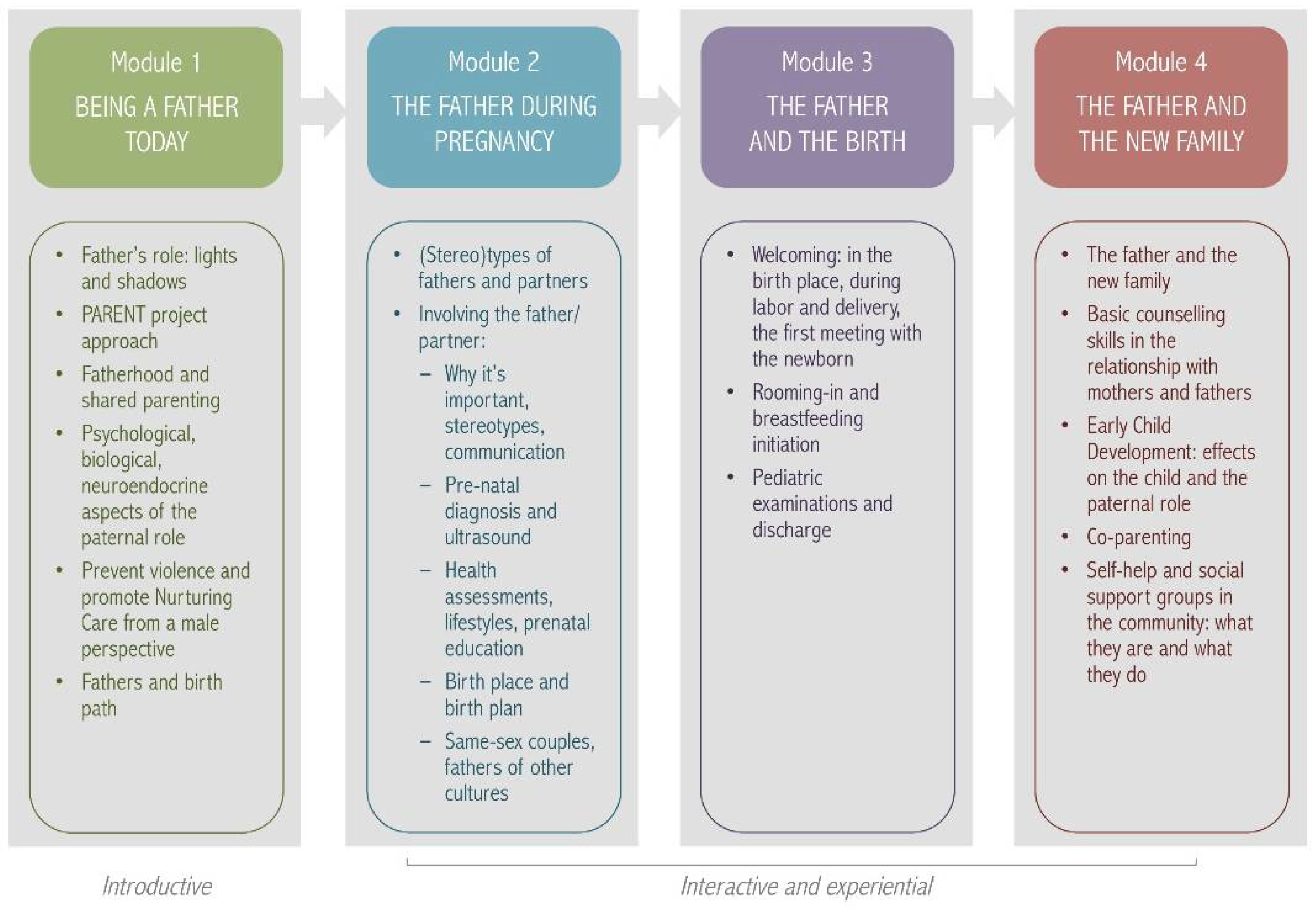
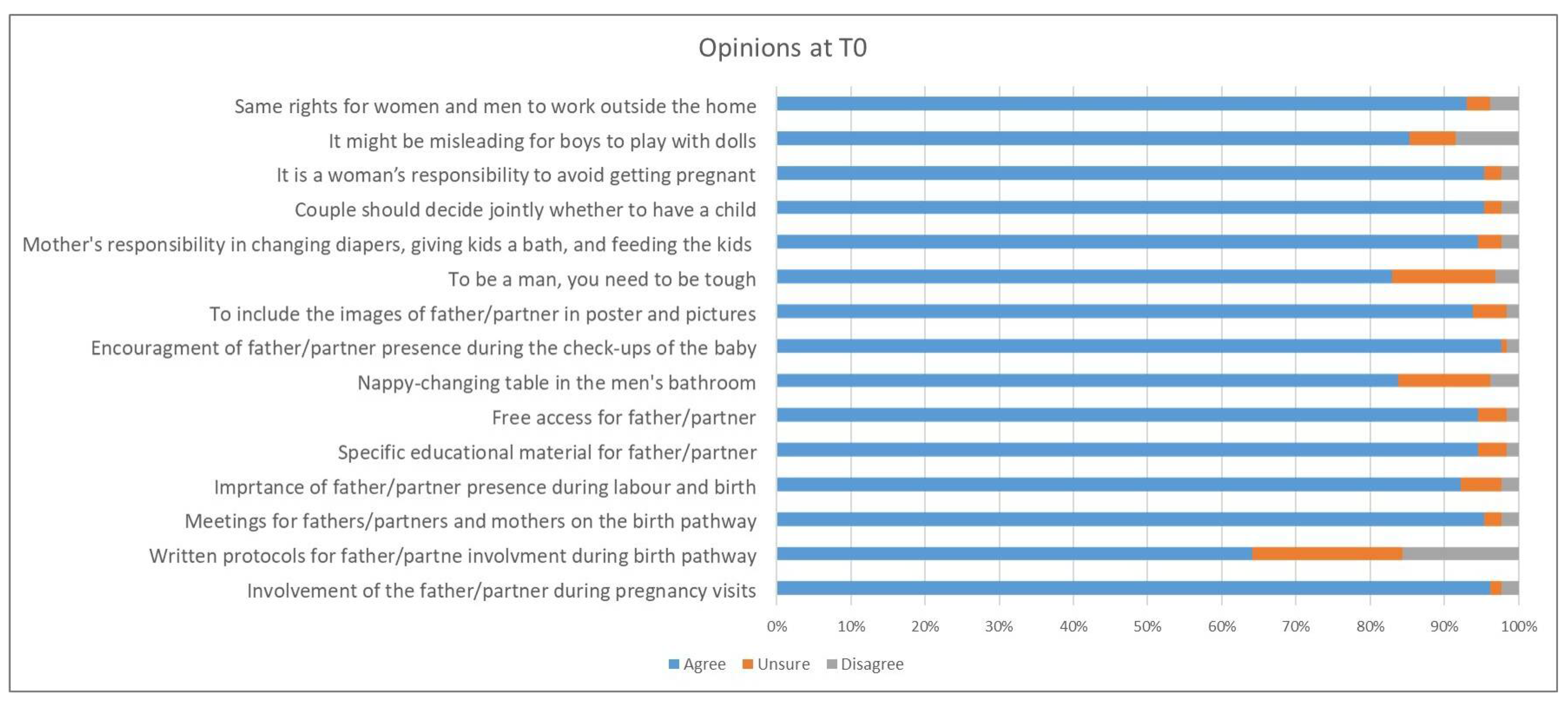
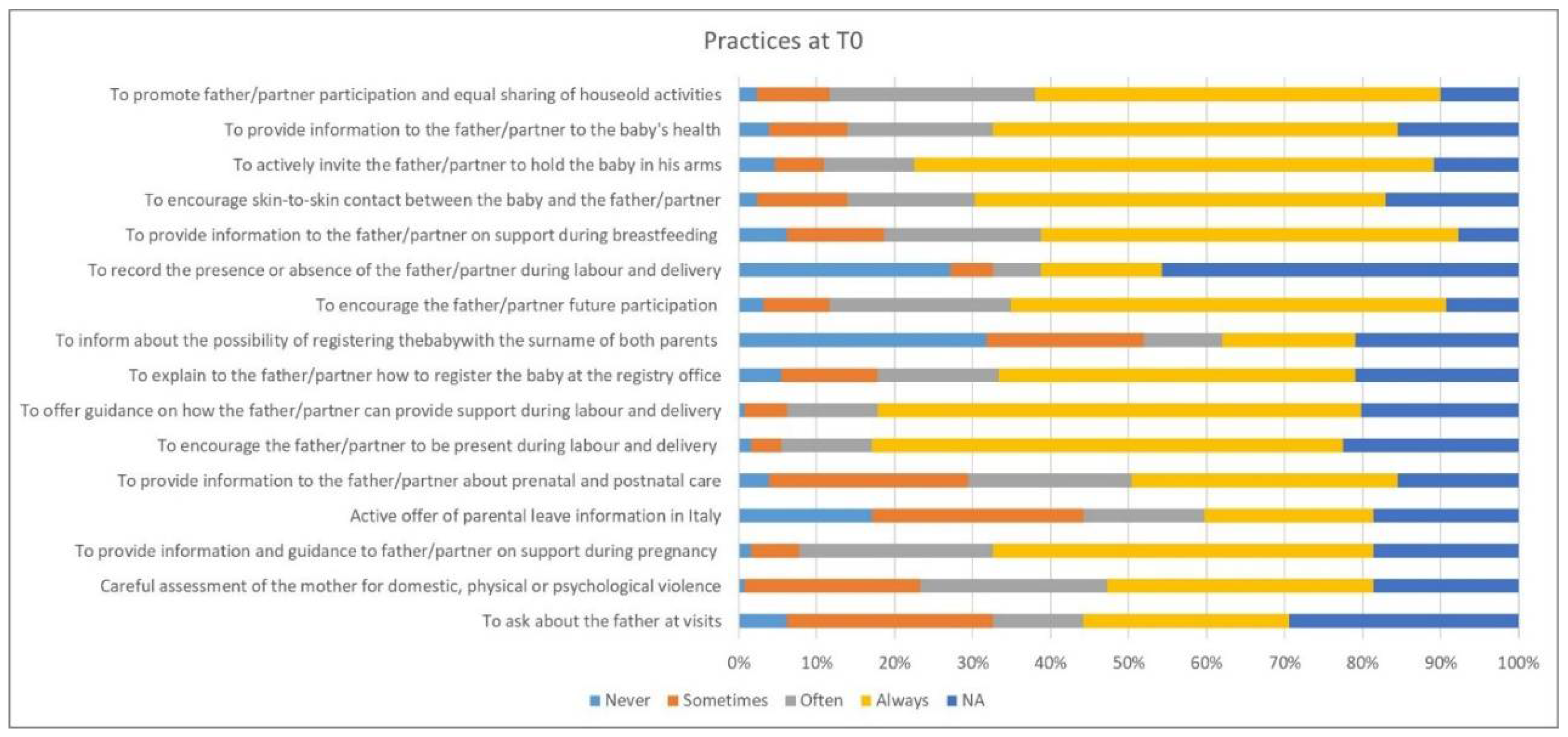
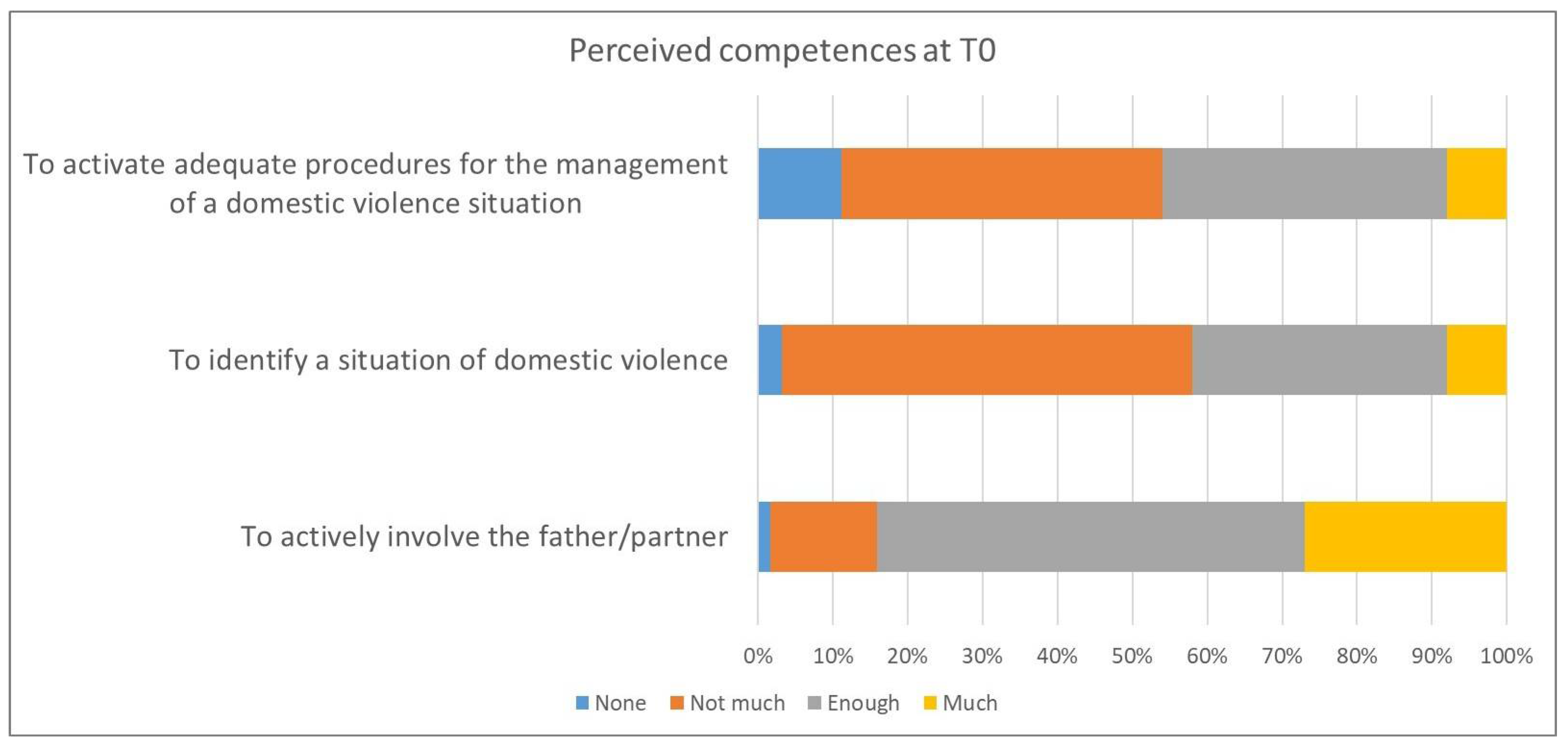
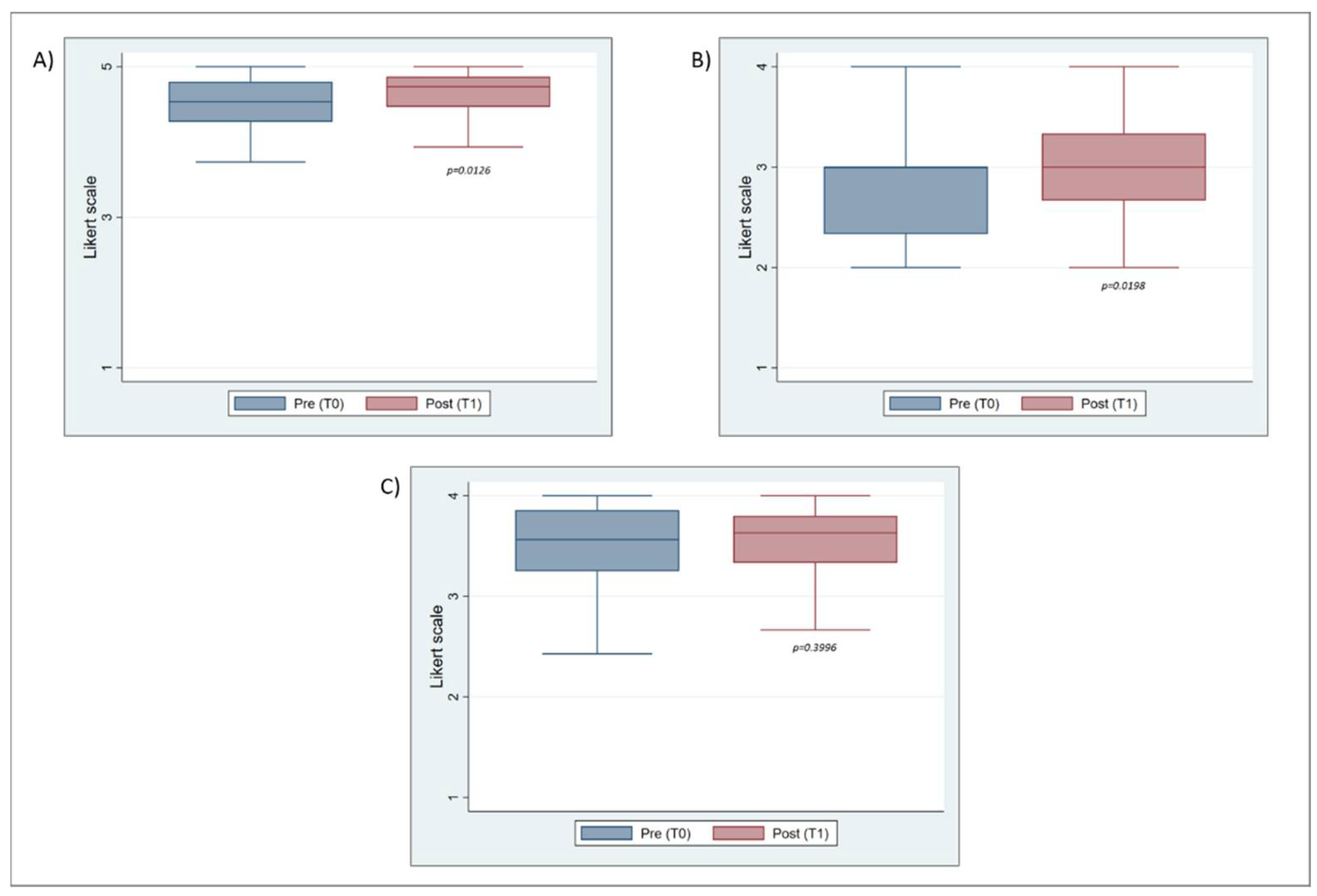
| Participants’ Data | N (%) |
|---|---|
| Mean age in years | 45.9 (SD ± 11.06) |
| Women | 120 (93) |
| Men | 9 (7) |
| Marital status | |
| Married | 71 (55) |
| Unmarried | 29 (22.5) |
| Cohabitant | 16 (12.4) |
| Divorced/separated | 10 (7.8) |
| Widower/widow | 3 (2.3) |
| Children (Yes) | 88 (68.2) |
| Educational level | |
| University degree | 92 (71.3) |
| Specialization | 20 (15.5) |
| Master’s degree | 17 (13.2) |
| Professionals (n = 128) | |
| Midwives | 85 (66.4) |
| Pediatricians/neonatologist | 12 (9.4) |
| Pediatric nurses | 9 (7) |
| Nurses | 8 (6.3) |
| Gynecologist | 4 (3.1) |
| Health care assistant | 4 (3.1) |
| Psychologist/psychotherapist | 6 (4.7) |
| Workplace (n = 127) | |
| Community healthcare services | 64 (50.4) |
| Hospital | 60 (47.2) |
| Research | 2 (1.6) |
| Academia | 1 (0.8) |
| Specific training/education (n = 127) | |
| No | 71 (56) |
| Yes, training on prevention of domestic violence | 35 (27.6) |
| Yes, training on active fatherhood | 12 (9.4) |
| Yes, training on both topics | 9 (7) |
Publisher’s Note: MDPI stays neutral with regard to jurisdictional claims in published maps and institutional affiliations. |
© 2022 by the authors. Licensee MDPI, Basel, Switzerland. This article is an open access article distributed under the terms and conditions of the Creative Commons Attribution (CC BY) license (https://creativecommons.org/licenses/by/4.0/).
Share and Cite
Zambri, F.; Santoro, A.; Lubbock, A.; Volta, A.; Bestetti, G.; Marchetti, F.; Pecilli, P.; Nassa, E.; Preziosi, J.; Colaceci, S.; et al. Training of Health Professionals to Promote Active Fatherhood during the Pre and Post-Natal Care to Prevent Violence against Women. Sustainability 2022, 14, 9341. https://doi.org/10.3390/su14159341
Zambri F, Santoro A, Lubbock A, Volta A, Bestetti G, Marchetti F, Pecilli P, Nassa E, Preziosi J, Colaceci S, et al. Training of Health Professionals to Promote Active Fatherhood during the Pre and Post-Natal Care to Prevent Violence against Women. Sustainability. 2022; 14(15):9341. https://doi.org/10.3390/su14159341
Chicago/Turabian StyleZambri, Francesca, Andrea Santoro, Annina Lubbock, Alessandro Volta, Giovanna Bestetti, Francesca Marchetti, Paola Pecilli, Elisabetta Nassa, Jessica Preziosi, Sofia Colaceci, and et al. 2022. "Training of Health Professionals to Promote Active Fatherhood during the Pre and Post-Natal Care to Prevent Violence against Women" Sustainability 14, no. 15: 9341. https://doi.org/10.3390/su14159341
APA StyleZambri, F., Santoro, A., Lubbock, A., Volta, A., Bestetti, G., Marchetti, F., Pecilli, P., Nassa, E., Preziosi, J., Colaceci, S., & Giusti, A. (2022). Training of Health Professionals to Promote Active Fatherhood during the Pre and Post-Natal Care to Prevent Violence against Women. Sustainability, 14(15), 9341. https://doi.org/10.3390/su14159341







